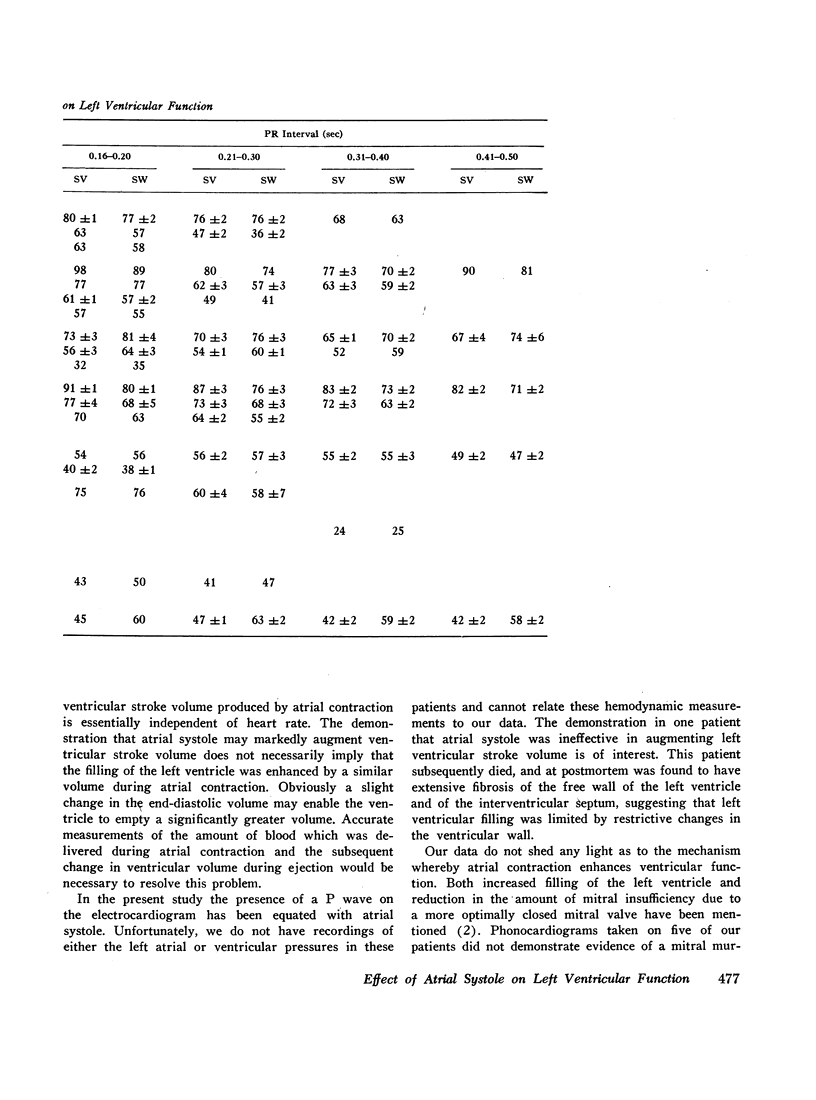Abstract
In order to evaluate the effects of atrial contraction on left ventricular function, the pressure gradient technique was used to measure instantaneous aortic blood flow and pressure in nine patients, six having complete heart block and three having normal sinus rhythm. From these data both left ventricular stroke volume and stroke work were calculated. Ventricular rate was controlled by transvenous right ventricular pacing over a range of 50-158 beats/min. At each heart rate, beats which were not preceded by a P wave served as controls. The other beats were divided into six groups according to the duration of the preceding PR interval. The results indicated that stroke volume and stroke work were always affected similarly. In one patient the presence of a P wave did not alter the subsequent stroke volume significantly. In the other patients, beats preceded by P waves had stroke volumes greater than the controls. In general, there was no difference in stroke volume for beats preceded by a P wave having a PR interval within the range of 0.05-0.20 sec. As the PR interval lengthened beyond 0.20 sec stroke volume tended to decrease, especially at more rapid heart rates. The absolute increase in stroke volume after a beat preceded by a P wave (PR interval 0.05-0.20 sec) was quite variable among the patients. For a given patient the absolute increase in stroke volume was essentially independent of heart rate. The percentage change in stroke volume, however, was always greater as the heart rate increased.
These data indicate that in most patients atrial systole is important in augmenting ventricular stroke volume and stroke work especially at high heart rates, but the magnitude of these effects are quite variable among patients.
Full text
PDF






Selected References
These references are in PubMed. This may not be the complete list of references from this article.
- Benchimol A. Significance of the contribution of atrial systole to cardiac function in man. Am J Cardiol. 1969 Apr;23(4):568–571. doi: 10.1016/0002-9149(69)90010-1. [DOI] [PubMed] [Google Scholar]
- Carleton R. A., Passovoy M., Graettinger J. S. The importance of the contribution and timing of left atrial systole. Clin Sci. 1966 Feb;30(1):151–159. [PubMed] [Google Scholar]
- Gillespie W. J., Greene D. G., Karatzas N. B., Lee G. D. Effect of atrial systole on right ventricular stroke output in complete heart block. Br Med J. 1967 Jan 14;1(5532):75–79. doi: 10.1136/bmj.1.5532.75. [DOI] [PMC free article] [PubMed] [Google Scholar]
- Greenfield J. C., Jr, Fry D. L. Relationship between instantaneous aortic flow and the pressure gradient. Circ Res. 1965 Oct;17(4):340–348. doi: 10.1161/01.res.17.4.340. [DOI] [PubMed] [Google Scholar]
- HERNANDEZ R. R., GREENFIELD J. C., Jr, MCCALL B. W. PRESSURE-FLOW STUDIES IN HYPERTROPHIC SUBAORTIC STENOSIS. J Clin Invest. 1964 Mar;43:401–407. doi: 10.1172/JCI104924. [DOI] [PMC free article] [PubMed] [Google Scholar]
- Harley A., Starmer C. F., Greenfield J. C., Jr Pressure-flow studies in man. An evaluation of the duration of the phases of systole. J Clin Invest. 1969 May;48(5):895–905. doi: 10.1172/JCI106048. [DOI] [PMC free article] [PubMed] [Google Scholar]
- LINDEN R. J., MITCHELL J. H. Relatonship between left ventricular diastolic pressure and myocardial segment length and observations on the contribution of atrial systole. Circ Res. 1960 Sep;8:1092–1099. doi: 10.1161/01.res.8.5.1092. [DOI] [PubMed] [Google Scholar]
- MITCHELL J. H., GILMORE J. P., SARNOFF S. J. The transport function of the atrium. Factors influencing the relation between mean left atrial pressure and left ventricular end diastolic pressure. Am J Cardiol. 1962 Feb;9:237–247. doi: 10.1016/0002-9149(62)90043-7. [DOI] [PubMed] [Google Scholar]
- MITCHELL J. H., GUPTA D. N., PAYNE R. M. INFLUENCE OF ATRIAL SYSTOLE ON EFFECTIVE VENTRICULAR STROKE VOLUME. Circ Res. 1965 Jul;17:11–18. doi: 10.1161/01.res.17.1.11. [DOI] [PubMed] [Google Scholar]
- SKINNER N. S., Jr, MITCHELL J. H., WALLACE A. G., SARNOFF S. J. HEMODYNAMIC EFFECTS OF ALTERING THE TIMING OF ATRIAL SYSTOLE. Am J Physiol. 1963 Sep;205:499–503. doi: 10.1152/ajplegacy.1963.205.3.499. [DOI] [PubMed] [Google Scholar]
- Snell R. E., Luchsinger P. C., Shugoll G. I. The relationship between the timing of atrial systole and the useful work of the left ventricle in man. Am Heart J. 1966 Nov;72(5):653–658. doi: 10.1016/0002-8703(66)90348-6. [DOI] [PubMed] [Google Scholar]
- Williams J. C., O'Donovan T. P., Cronin L., Wood E. H. Influence of sequence of atrial and ventricular systoles on closure of mitral valve. J Appl Physiol. 1967 Apr;22(4):786–792. doi: 10.1152/jappl.1967.22.4.786. [DOI] [PubMed] [Google Scholar]


